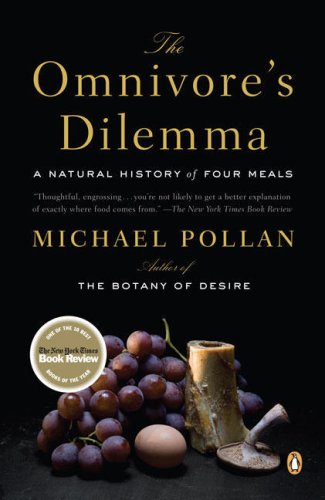
I found this book to be extremely interesting, especially because I read In Defense of Food previously. Although this book came before, it still makes some very interesting points and teaches the reader a lot about healthy eating. The book is divided up into 3 sections: getting food industrially, getting food from a pasture, and getting food by yourself (gardening).
In the first section, Pollan delves into the field of corn and how it is prevalent in many things we consume. It’s in more than you think. It can be eaten as corn, put into chemicals, or fed to animals which we later consume. The way corn has dominated America is very interesting. At the end of the section, Pollan describes a McDonald’s meal and explains why everything in the meal contains corn. The percentages are much higher than one would expect, meaning that corn really does have a lot to do with the American diet, which I find extremely interesting. It makes one wonder if the supply can meet the demand.
The next section deals with organic food and the surge of popularity it has experienced as many people have decided to start eating healthier. Whereas the first section focused mainly on corn, this one focused on grass in the sense of produce (grass-fed beef, etc.) Despite the loose definition of the term “organic,” it can be seen that all organic food is healthier than corn-based food. The problem is that transportation is a huge cost of the organic food as it is not grown everywhere. He visits a small rotation farm where waste is minimized as much as possible. Though this is obviously better for the environment, it is harder to accomplish. The meal at the end of this section is described as much better than McDonalds, and considering that none of it was processed, is probably much healthier as well.
The final section, and probably the hardest part of the book to follow in real life, is a hunter-gatherer type diet in which one only prepares food that they can hunt, gather or grow for himself. Local people help him in his quest to make a meal. While this is not only the healthiest diet one can follow, it is very impractical and takes up a lot of time. However, it is good as a way of remembering how food consumption was before industrialization. The meal described at the end of the chapter sounds delicious, but again, would be hard to replicate 21 times a week if one chose to follow that lifestyle.
Overall, I really enjoyed this book; Pollan has a unique writing style that is extremely interesting. Since reading two of his books, I have started considering more environmentally-friendly ways to eat as well as ways that would benefit my health. I highly recommend this book for anybody interested in the subject of food or just looking for a good read in general.
No comments:
Post a Comment